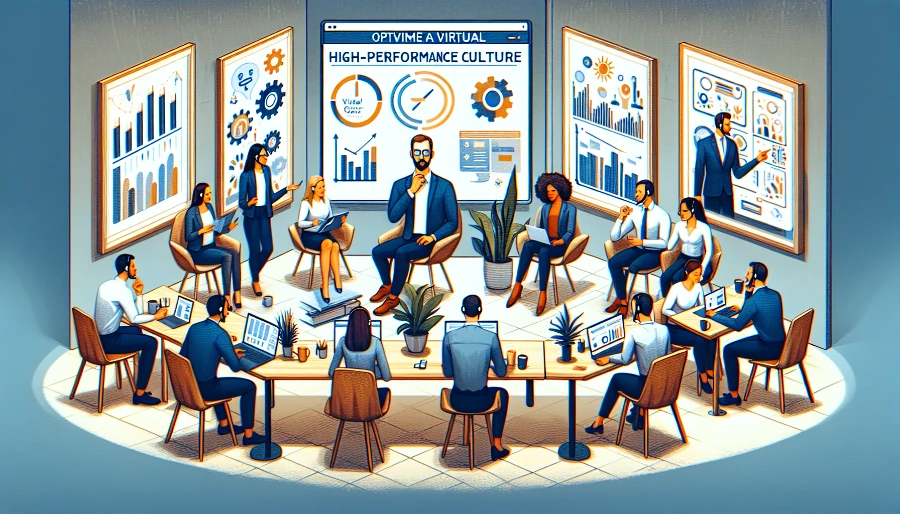Introduction
Building a virtual high-performance culture is essential for running effective online meetings. In a virtual setting, it is crucial to establish clear guidelines, roles, and responsibilities to ensure maximum productivity and engagement. Setting the tone for virtual meetings involves setting ground rules, assigning roles, and ensuring active participation from all team members.
One key aspect of fostering a virtual high-performance culture is to create a sense of community and connection among team members. Encouraging casual check-ins, introducing team members, and assigning specific roles during meetings can help create a more engaging and collaborative environment.
Another important factor in maintaining a high-performance culture in virtual meetings is effective communication. Providing clear agendas, creating visuals for data presentation, and setting up feedback loops can help keep team members engaged and focused on the meeting objectives.
Setting Up Your Online Meeting Platform
When setting up your online meeting platform, it’s crucial to choose a tool that aligns with your company’s needs and fosters effective communication. Consider using platforms like Zoom, Google Meet, or Crowdcast, which offer interactive features such as live polls, chat functionality, and screen-sharing options.
For large meetings involving voting members who are not part of your immediate team, platforms like Crowdcast can be beneficial, allowing you to set up accounts for participants and facilitate live interactions, polls, and voting mechanisms to ensure engagement.
To ensure accessibility for all participants, consider tools like Otter AI with Zoom, which provides automatic transcription for those who are hard of hearing. Additionally, platforms like Canva can be useful for creating visually engaging presentations to share during your online meetings.
When conducting online meetings, make sure to maintain eye contact with the camera as much as possible to create a sense of connection with your remote team members. Over-communicate and provide clear instructions to ensure everyone is on the same page throughout the meeting.
Creating a Virtual Water Cooler Environment
Creating a virtual water cooler environment is essential for fostering a sense of community and connection among team members in a remote setup. Encouraging casual check-ins, introducing team members, and assigning specific roles during meetings can help create a more engaging and collaborative environment.
To maintain a high-performance culture in virtual meetings, it is crucial to provide space for team members to interact informally. One way to do this is by setting up a virtual water cooler where team members can connect outside of formal meetings.
Platforms like Slack, Yammer, or Microsoft Teams allow for creating channels where team members can have casual conversations and connect with each other.
Another way to enhance team engagement is by creating shared traditions like a daily check-in or virtual happy hour. These fun and informal rituals can help boost team morale and create a sense of community even in a remote setting.
By encouraging team members to engage in a virtual water cooler environment, you can help them feel more connected, motivated, and engaged during online meetings, ultimately contributing to a high-performance culture in your virtual work environment.
Running an Effective Online Meeting
Running an effective online meeting involves setting clear guidelines, roles, and responsibilities to ensure maximum productivity and engagement. It is crucial to establish ground rules at the beginning of the meeting, assign roles to team members, and set the tone for active participation.
To keep team members engaged and focused, it’s essential to maintain eye contact with the camera, provide clear instructions, and create visuals for data presentation. Utilizing tools like Zoom, Google Meet, or Crowdcast can help facilitate interactive features such as live polls, chat functionality, and screen-sharing options.
When setting up your online meeting platform, consider the participants’ needs, the meeting size, and the functionalities required. Choose a platform that aligns with your company’s needs and fosters effective communication to ensure engagement and collaboration among team members.
Additionally, creating a sense of community and connection through tools like Slack, Yammer, or Microsoft Teams can help enhance team engagement and boost morale.
Assigning specific roles, setting ground rules, using interactive features, and creating a positive virtual environment are key elements in running an effective online meeting. By following these tips, you can ensure that your virtual meetings are engaging, productive, and contribute to a virtual high-performance culture within your team.
Engagement Strategies for Remote Meetings
Engaging team members in remote meetings is crucial for maintaining a high-performance culture. To foster engagement, it is essential to create a virtual water cooler environment where team members can interact informally.
Encouraging casual check-ins, assigning specific roles during meetings, and creating shared traditions like daily check-ins or virtual happy hours can help build a sense of community and connection among team members.
To enhance team engagement, it is important to assign specific roles during meetings and set ground rules to ensure active participation. Designating a timekeeper, setting clear guidelines for interaction, and maintaining eye contact with the camera can help keep team members engaged and focused during online meetings.
Utilizing interactive features like polls, live chat functionality, and screen-sharing options can also enhance engagement during remote meetings. Platforms like Zoom, Google Meet, or Crowdcast offer tools for interactive engagement and collaboration among team members.
Additionally, creating visuals for data presentations and using tools like Canva for visually engaging presentations can help keep team members engaged and focused on meeting objectives.
To ensure effective communication and engagement during remote meetings, it is crucial to provide clear agendas, designate roles, and maintain a positive virtual environment. By following these strategies, you can ensure that your virtual meetings are engaging, productive, and contribute to a virtual high-performance culture within your team.
End of Meeting Procedures
As the virtual meeting comes to a close, it is essential to ensure that all participants are aligned on the key takeaways and action items. Before ending the meeting, it’s crucial to review the deliverables, next steps, and who is responsible for following up on each task.
Make sure to clarify when those deliverables are due and when the next check-in or meeting will be scheduled.
It’s recommended to go through these items with the team before concluding the meeting. If participants are unsure of any information, make sure to email a recap with a detailed breakdown of the discussed topics, deliverables, and action items.
This recap email will help reinforce the information shared during the meeting and ensure everyone is on the same page moving forward.
Don’t forget to ask for feedback from the participants to continuously improve the effectiveness of your virtual meetings. Creating a feedback loop allows team members to share their thoughts and suggestions for making future meetings more engaging and productive.
Encouraging open communication and feedback will help build a collaborative and high-performance virtual work environment.
Handling Interruptions and Ensuring Participation
During online meetings, interruptions can be a common issue. To address this, it’s essential to establish ground rules at the beginning of the meeting and assign roles to team members.
Designate a timekeeper who can ensure that the meeting stays on track and that everyone has a chance to speak.
To manage interruptions effectively, set guidelines for interaction during the actual meeting. Clearly define the rules of engagement and let your team members know what is expected of them.
Encourage active participation and ensure that everyone has an opportunity to contribute to the discussion.
By creating a structured environment with designated roles and guidelines, you can minimize interruptions and keep the meeting focused and productive.
Make sure to communicate these rules ahead of time and reinforce them during the meeting to maintain a positive and engaging virtual work environment.
Tools and Techniques for Large Committee Meetings
When it comes to conducting large committee meetings involving voting members who are not part of your immediate team, it’s essential to leverage the right tools and techniques to ensure effective communication and engagement.
Platforms like Crowdcast can be beneficial for setting up accounts for participants and facilitating live interactions, polls, and voting mechanisms to ensure engagement.
To ensure accessibility for all participants, consider using tools like Otter AI with Zoom, which provides automatic transcription for those who are hard of hearing.
Additionally, platforms like Canva can be useful for creating visually engaging presentations to share during your online meetings.
During large committee meetings, it’s crucial to maintain engagement and communication with all participants. Setting clear guidelines, assigning specific roles, and using interactive features like live polls, chat functionality, and screen-sharing options can help keep team members engaged and focused.
By utilizing these tools and techniques, you can ensure that your large committee meetings are productive, engaging, and contribute to a collaborative virtual environment.
Visuals and Screen Sharing Options
When conducting online meetings, it is essential to utilize tools that provide effective communication and engagement. Platforms like Zoom, Google Meet, Crowdcast, and Microsoft Teams offer interactive features such as live polls, chat functionality, and screen-sharing options.
These tools help keep team members engaged and focused on meeting objectives by allowing visual presentations and data sharing.
For large committee meetings involving voting members who are not part of your immediate team, platforms like Crowdcast can be beneficial. These platforms enable you to set up accounts for participants and facilitate live interactions, polls, and voting mechanisms to ensure engagement among all attendees.
To enhance accessibility for all participants, tools like Otter AI with Zoom provide automatic transcription for those who are hard of hearing.
Additionally, platforms like Canva can be useful for creating visually engaging presentations to share during your online meetings. Utilizing visuals and screen-sharing options can significantly enhance engagement and collaboration in virtual meetings.
Remember to maintain eye contact with the camera, provide clear instructions, and create visuals for data presentation. Utilizing these visual aids will help keep team members engaged, focused, and actively participating during online meetings, ultimately contributing to a virtual high-performance culture within your team.
Conclusion and Next Steps
As you embark on creating a virtual high-performance culture, it’s important to remember the key aspects discussed in this guide. Establishing clear guidelines, assigning roles, and fostering engagement are crucial for running effective online meetings.
By creating a sense of community through casual check-ins, shared traditions, and assigning specific roles, you can help build a more engaging and collaborative environment for your team.
Setting up your online meeting platform with interactive features like live polls, chat functionality, and screen-sharing options is essential for engaging remote team members.
Utilizing tools like Zoom, Google Meet, or Crowdcast can help facilitate interactive engagement and collaboration among team members, ultimately contributing to a high-performance culture in your virtual work environment.
Remember to maintain eye contact with the camera, provide clear instructions, and create visuals for data presentation to keep team members engaged and focused during online meetings.
By utilizing visuals and screen-sharing options effectively, you can ensure that your virtual meetings are engaging, productive, and contribute to a virtual high-performance culture within your team.







